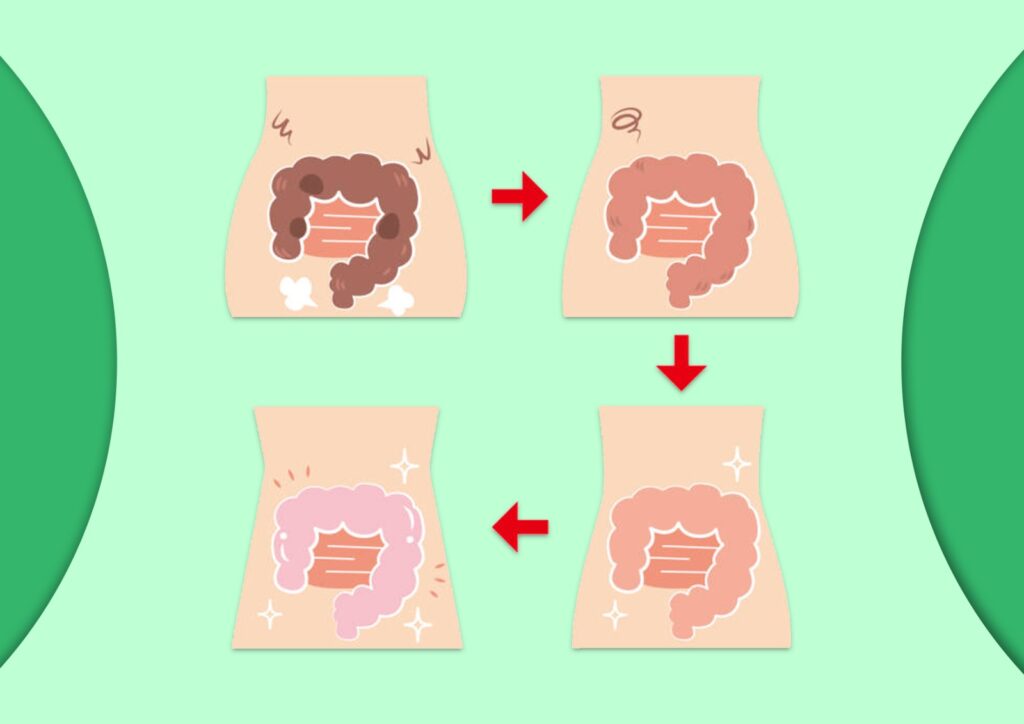How to Get Rid of Stomach Ache in 5 Minutes

My journey with stomach pain was a challenging one, filled with uncertainty and frustration. It started with occasional discomfort after meals, but gradually, it became more frequent and intense. At first, I brushed it off as mere indigestion, attributing it to my erratic eating habits and stress. As days went by, when the discomfort converted into a persistent ache that affected my daily activities, I knew I had to dig deeper.
I researched and came to know that stomach pain can stem from various underlying factors, with two major culprits being Gas and Inflammation.
Gas-related pain often arises from trapped air in the digestive tract, leading to bloating and discomfort.
On the other hand, Inflammation, commonly caused by conditions like gastritis or ulcers, results in persistent pain and irritation in the stomach lining.
The list of reasons for experiencing a stomach ache is a lengthy one. However, Some other possible causes of Stomach pain are:
- Eating too quickly leads to aerophagia, where excessive air swallowing causes bloating, gas, burping, and belching.
- Heartburn or acid reflux is often described as a burning sensation rather than an ache. It’s prevalent, with about one in five adults experiencing either issue.
- A peptic ulcer is an open sore in the stomach or adjacent duodenum, causing gnawing or burning pain, along with indigestion, nausea, vomiting, and gas.
- Gastritis is inflammation in the stomach lining caused by alcohol, aspirin, H. pylori infection, and extreme stress.
- Food allergies stem from IgE, which can induce an inflammatory response in the digestive tract, resulting in cramps, stomachaches, nausea, and diarrhoea.
- Lactose Intolerance results in diarrhoea, gas, or bloating, as per the Mayo Clinic. Sixty-five percent of the global population has some sort of inability to digest lactose.
- Indigestion, also known as dyspepsia, is often triggered by overeating, fast eating, fatty or spicy foods, excessive caffeine or alcohol consumption, smoking, anxiety, or certain medications like antibiotics or pain relievers. Indigestion signs include pain in the upper middle belly, nausea, bloating, burping, and heartburn.
- Gas moving through the digestive tract can stretch the stomach and intestines, leading to sharp, jabbing pain accompanied by bloating and cramping.
- Constipation pain typically results from gas buildup or the slow passage of hardened stools through the colon (large intestine).
- Food poisoning from bacteria like E. coli and Salmonella can cause nausea, stomach pain, cramping, and vomiting as the body tries to purge the body of the bacterial toxin.
- Irritable bowel syndrome (IBS) causes inflammation in the digestive tract, leading to abdominal pain in the lower belly, cramps, bloating, gas, diarrhoea, and constipation.
- Appendicitis pain arises suddenly and can be intense, initially focusing on the lower right side of the stomach and potentially shifting to the belly button area. Symptoms may also include nausea, vomiting, or fever.
Determined to pinpoint the source of my discomfort, I began to pay closer attention to my symptoms. Alongside the persistent ache, I noticed bloating, burping, and occasional heartburn, indicating a possible link to gas-related issues.
I knew I needed help when my symptoms got worse. I went to see a doctor, and he prescribed over-the-counter medications like antacids or proton pump inhibitors to help with the pain, but it didn’t work well for me.
Instead of feeling better, I felt worse. I realised that medicine wasn’t the only answer that I was looking for. I quickly searched online for how to relieve upper stomach pain immediately.
Getting rid of a stomach ache right away may not always be possible. However, some simple tricks to get rid of stomach ache in 5 minutes include-
- Drink warm water with lemon: This helps stimulate digestion and alleviate bloating.
- Take a brisk walk: Movement aids in digestion and helps relieve gas.
- Practice deep breathing: Deep breathing exercises can help relax the abdominal muscles and reduce pain.
- Gentle Abdominal Massage can help stimulate digestion and alleviate discomfort.
- Chew Fennel Seeds as it helps relieve gas and bloating.
- Taking Over-the-counter antacids to neutralise stomach acid and soothe irritation.
- Using a heating pad on the abdomen to relax muscles and alleviate cramping.
- Consuming ginger tea, peppermint tea, or chamomile tea to alleviate bloating and nausea.
- Eating smaller, more frequent meals to ease digestion.
- Use peppermint oil: Rubbing diluted peppermint oil on the abdomen can soothe digestive discomfort.
While these short-term measures provided temporary relief, long-term healing required a more comprehensive approach. Stomach ache is among the most common problems affecting people of all age groups due to varied reasons.

Some of the common Natural remedies for stomach pain that helped me are-
- Anti-inflammatory foods: help reduce abdominal pain. These foods include blueberries, squash, cherries, capsicum, tomatoes, cold-water fish high in omega-3 fatty acids, beans, green leafy vegetables, and almonds.
- Herbs to reduce cramps: Chamomile tea, peppermint, fennel, cinnamon, ginger, turmeric root, and dill are some herbs that have anti-inflammatory effects and can reduce cramps. Sipping two cups of tea containing these herbs per day can help reduce abdominal pain.
- Basil contains substances that reduce gas. Its leaves also contain levels of high linoleic acid, which has anti-inflammatory properties.
- Mint (Pudina): rich in antioxidants and phytonutrients, and aids in synthesising digestive enzymes. Its soothing effect on stomach muscles reduces acidity and flatulence.
- BRAT diet: that is, bananas, rice, applesauce, and toast. These foods are bland, low in fibre, and high in binding properties. It’s a great way to help combat nausea and diarrhoea.
- Spices: Certain spices such as cinnamon, clove, asafoetida, fennel seeds, and cumin are used to soothe an upset stomach. They have anti-inflammatory properties and can help with slow digestion. These spices may ease cramps, acidity, indigestion, gas, bloating, belching, and other digestive issues. You can add them to your food or make tea by boiling them in water and drinking the liquid 2-3 times a day.
- Incorporating probiotics into daily routine promotes gut health and helps maintain a healthy balance of bacteria in the digestive tract.
- Bananas are natural antacids that can help soothe an upset stomach by neutralising stomach acid and reducing inflammation. They contain potassium, which replaces electrolytes lost due to vomiting or diarrhoea.
- Rice is a simple, easily digestible carbohydrate that can help settle an upset stomach. It can help absorb excess stomach acid and soothe the stomach lining.
- Initially, consume a liquid diet. Drink clear fluids, such as water, fruit juices mixed with water, ginger ale, or a simple broth.
- As the pain starts to go away, introduce bland foods in your diet, such as plain bread, dry toast, rice, and bananas.
- Eating practices: Chew food slowly, no talking while eating, ensure the food is well cooked,and no lying down immediately after eating.
- Try gentle movement– Consistent exercise can prevent a lack of bowel movement and constipation.
- Pay attention to hunger signals– eating regular meals lessens the chances of experiencing discomfort as frequently.
- Increase your fibre intake– Besides preventing constipation, consuming insoluble fibre reduces the risk of colon cancer. It also acts as a prebiotic, balancing the intestinal gut flora and nourishing beneficial bacteria.
- Drinking plenty of water helps keep the digestive system functioning smooth.
- Manage stress as it exacerbates stomach issues, so finding healthy ways to cope, such as meditation or yoga, is essential.
- Maintain a healthy weight: Excess weight can put pressure on the abdomen, leading to digestive issues.
My meals became a colourful array of fruits, vegetables, lean proteins, whole grains, and healthy fats, each serving as a building block for my body’s healing process. I discovered the healing power of foods such as turmeric, ginger, garlic, and green tea, each offering a unique blend of nutrients and compounds to support digestive health and reduce inflammation.
Some Drinks that helped ease the stomach pain are:
- Coconut water contains nutrients like magnesium and potassium that help to reduce stomach contractions, muscle spasms, and stomach pain.
- Milk helps neutralise the stomach acid and relieves stomach aches.
- Ginger tea reduces inflammation and pain while promoting blood circulation and aiding digestion as a mild stimulant.
- Peppermint tea helps relieve stomach cramps, farting, and bloating, especially in people with Crohn’s disease or ulcerative colitis. It works by helping the muscles of the digestive system to relax.
- Aloe vera juice offers relief from acid reflux, promotes bowel movements, aids in protein digestion, reduces Inflammation, and enhances the balance of bacteria in the gut.
- Apple cider vinegar: Drinking one tablespoon of apple cider vinegar mixed in one cup of warm water with honey can relieve gas or indigestion in people with an upset stomach.
- Lemon water hydrates and helps in reducing stomach aches and cramps effectively.
After implementing these short-term and long-term solutions, I began to experience relief from my stomach pain. However, the real turning point came when I started paying closer attention to my diet. I Avoided practices like:
- Spicy foods, fried or fatty foods, rich and creamy foods, and heavily preserved foods that are harder to digest, cause stomach aches and increase inflammation.
- Gas-producing veggies such as Asparagus, Broccoli, Brussels sprouts, cabbage, onions as they cause stomach pain and discomfort.
- Lying down to prevent indigestion from becoming heartburn.
- Smoking and drinking alcohol as they irritate the stomach lining and exacerbate inflammation.
- Carbonated, caffeinated, fatty, or sweetened liquids, such as sodas, tea, coffee, milk, and sports drinks.
- Sugary food, white bread or pasta, alcohol, caffeine, and tobacco as they increase cramps.
- Eating close to bedtime can disrupt digestion and lead to discomfort during the night.
By eliminating these practices, I noticed a significant improvement in my digestive health. Today, I no longer live in fear of stomach pain disrupting my life, thanks to these simple yet effective strategies.





